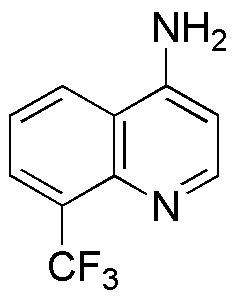4-Amino-8-(trifluoromethyl)quinoline is widely utilized in research focused on:
- Pharmaceutical Development: This compound serves as a key intermediate in synthesizing various pharmaceuticals, particularly in developing anti-malarial and anti-cancer agents.
- Fluorescent Probes: Its unique structure allows it to be used in creating fluorescent probes for biological imaging, enhancing the visualization of cellular processes.
- Material Science: The compound's properties make it suitable for developing advanced materials, including polymers and coatings with enhanced thermal and chemical resistance.
- Analytical Chemistry: It is employed in analytical methods for detecting and quantifying specific analytes in complex mixtures, benefiting industries like food safety and environmental monitoring.
- Research in Organic Synthesis: The compound is a valuable building block in organic synthesis, allowing researchers to explore new chemical reactions and develop innovative compounds.
General Information
Properties
Safety and Regulations
Applications
4-Amino-8-(trifluoromethyl)quinoline is widely utilized in research focused on:
- Pharmaceutical Development: This compound serves as a key intermediate in synthesizing various pharmaceuticals, particularly in developing anti-malarial and anti-cancer agents.
- Fluorescent Probes: Its unique structure allows it to be used in creating fluorescent probes for biological imaging, enhancing the visualization of cellular processes.
- Material Science: The compound's properties make it suitable for developing advanced materials, including polymers and coatings with enhanced thermal and chemical resistance.
- Analytical Chemistry: It is employed in analytical methods for detecting and quantifying specific analytes in complex mixtures, benefiting industries like food safety and environmental monitoring.
- Research in Organic Synthesis: The compound is a valuable building block in organic synthesis, allowing researchers to explore new chemical reactions and develop innovative compounds.
Documents
Safety Data Sheets (SDS)
The SDS provides comprehensive safety information on handling, storage, and disposal of the product.
Product Specification (PS)
The PS provides a comprehensive breakdown of the product’s properties, including chemical composition, physical state, purity, and storage requirements. It also details acceptable quality ranges and the product's intended applications.
Certificates of Analysis (COA)
Search for Certificates of Analysis (COA) by entering the products Lot Number. Lot and Batch Numbers can be found on a product’s label following the words ‘Lot’ or ‘Batch’.
Número de catálogo
Número de lote/lote
Certificates Of Origin (COO)
This COO confirms the country where the product was manufactured, and also details the materials and components used in it and whether it is derived from natural, synthetic, or other specific sources. This certificate may be required for customs, trade, and regulatory compliance.
Número de catálogo
Número de lote/lote
Safety Data Sheets (SDS)
The SDS provides comprehensive safety information on handling, storage, and disposal of the product.
DownloadProduct Specification (PS)
The PS provides a comprehensive breakdown of the product’s properties, including chemical composition, physical state, purity, and storage requirements. It also details acceptable quality ranges and the product's intended applications.
DownloadCertificates of Analysis (COA)
Search for Certificates of Analysis (COA) by entering the products Lot Number. Lot and Batch Numbers can be found on a product’s label following the words ‘Lot’ or ‘Batch’.
Número de catálogo
Número de lote/lote
Certificates Of Origin (COO)
This COO confirms the country where the product was manufactured, and also details the materials and components used in it and whether it is derived from natural, synthetic, or other specific sources. This certificate may be required for customs, trade, and regulatory compliance.


